Advertisements
Advertisements
प्रश्न
Consider the situation shown in figure. The plates of the capacitor have plate area A and are clamped in the laboratory. The dielectric slab is released from rest with a length a inside the capacitor. Neglecting any effect of friction or gravity, show that the slab will execute periodic motion and find its time period.
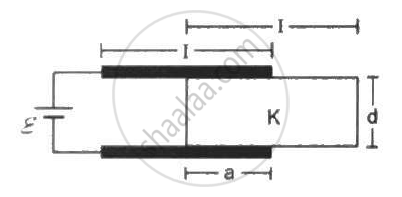
उत्तर
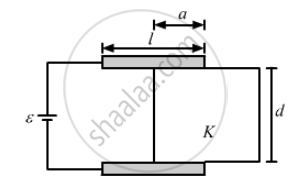
Given that the area of the plates of the capacitors is A.
As ''a'' length of the dielecric slab is inside the capacitor.
Therefore, the area of the plate covered with dielectric is `= A/la`
The capacitance of the portion with dielectric is given by `C_1 = (K∈_0Aa)/(ld)`
The capacitance of the portion without dielectric is given by `C_1 = (∈_0A(l-a))/(ld)`
The two parts can be considered to be in parallel.
Therefore, the net capacitance is given by
`C = C_1 + C_2`
`⇒ C = (∈_0A)/(ld)[Ka + (l-a)]`
`⇒ C = (∈_0A)/(ld)[l + a(K-1)]`
Let us consider a small displacement da of the slab in the inward direction. The capacitance will increase, therefore the energy of the capacitor will also increase. In order to maintain constant voltage, the battery will supply extra charges, therefore the battery will do work.
Work done by the battery = change in energy of capacitor + work done by the force F on the capacitor
`dW_B = dU + dW_F`
Let the charge dq is supplied by the battery, and the change in the capacitor be dC
`dW_B = (dq).V = (dC).V^2`
`dU = 1/2(dC).V^2`
`(dC).V^2 = 1/2(dC).V^2 + F.da`
`1/2(dC).V^2 = F.da`
`⇒ F = 1/2 (dC)/(da)V^2`
`⇒ F = 1/2 d/(da) ((∈_0A)/(ld)[l + a(K-1)])V^2`
`⇒ F = 1/2 (∈_0A)/(ld) (K - 1)`
The acceleration of the dielectric is given by `a_0 = 1/2 (∈_0A)/(ldm)(K-1)`
As, the force is in inward direction, it will tend to make the dielectric to completely fill the space inside the capacitors. As, the dielectric completely fills the space inside the capacitor at this instant its velocity is not zero. The dielectric slab tends to move outside the capacitor. As the slab tends to move out, the direction of the force due to the capacitor will reverse its direction. Thus, the dielectric slab will have a periodic motion.
The time taken to move distance `(l-a)` can be calculated as :-
`(l - a) = 1/2 a_0t^2`
`t = sqrt ((2(l-a))/(a_0))`
`t = sqrt (2(l-a) xx (2ldm)/(∈_0AV^2(K-1))`
`t = sqrt ((4m(l-a)ld)/(∈_0AV^2(K-1))`
For the complete cycle the time period will be four times the time taken for covering distance `(l-a)`.
It is given by :-
`T = 4t = 4 xx 2 sqrt((m(l-a)ld)/(∈_0AV^2(K-1))) = 8 sqrt ((m(l-a)ld)/(∈_0AV^2(K-1))`
APPEARS IN
संबंधित प्रश्न
A parallel plate capacitor of capacitance C is charged to a potential V. It is then connected to another uncharged capacitor having the same capacitance. Find out the ratio of the energy stored in the combined system to that stored initially in the single capacitor.
Three identical capacitors C1, C2 and C3 of capacitance 6 μF each are connected to a 12 V battery as shown.
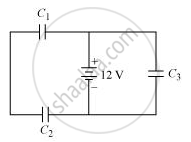
Find
(i) charge on each capacitor
(ii) equivalent capacitance of the network
(iii) energy stored in the network of capacitors
A thin metal plate P is inserted between the plates of a parallel-plate capacitor of capacitance C in such a way that its edges touch the two plates . The capacitance now becomes _________ .
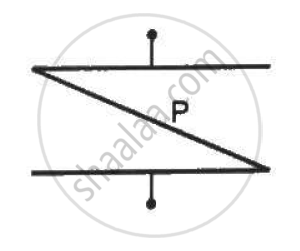
When 1⋅0 × 1012 electrons are transferred from one conductor to another, a potential difference of 10 V appears between the conductors. Calculate the capacitance of the two-conductor system.
The plates of a parallel-plate capacitor are made of circular discs of radii 5⋅0 cm each. If the separation between the plates is 1⋅0 mm, what is the capacitance?
Take `C_1 = 4.0 "uF" and C_2 = 6.0 "uF"` in figure . Calculate the equivalent capacitance of the combination between the points indicated.

A finite ladder is constructed by connecting several sections of 2 µF, 4 µF capacitor combinations as shown in the figure. It is terminated by a capacitor of capacitance C. What value should be chosen for C, such that the equivalent capacitance of the ladder between the points A and B becomes independent of the number of sections in between?
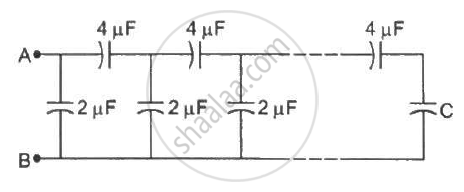
A capacitor of capacitance 2⋅0 µF is charged to a potential difference of 12 V. It is then connected to an uncharged capacitor of capacitance 4⋅0 µF as shown in figure . Find (a) the charge on each of the two capacitors after the connection, (b) the electrostatic energy stored in each of the two capacitors and (c) the heat produced during the charge transfer from one capacitor to the other.
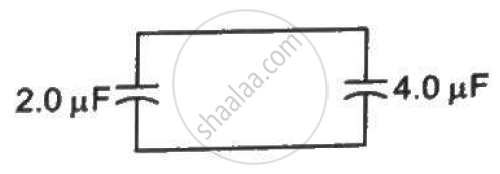
A parallel-plate capacitor of plate area A and plate separation d is charged to a potential difference V and then the battery is disconnected. A slab of dielectric constant K is then inserted between the plates of the capacitor so as to fill the space between the plates. Find the work done on the system in the process of inserting the slab.
If the voltage applied on a capacitor is increased from V to 2V, choose the correct conclusion.
Three capacitors are connected in a triangle as shown in the figure. The equivalent capacitance between points A and C is ______.

Explain in detail the effect of a dielectric placed in a parallel plate capacitor.
- Charge on each capacitor remains same and equals to the main charge supplied by the battery.
- Potential difference and energy distribute in the reverse ratio of capacitance.
- Effective capacitance is even les than the least of teh individual capacitances.
When air is replaced by a dielectric medium of constant K, the maximum force of attraction between two charges separated by a distance ______.
Three capacitors 2µF, 3µF, and 6µF are joined in series with each other. The equivalent capacitance is ____________.
Can the potential function have a maximum or minimum in free space?
For changing the capacitance of a given parallel plate capacitor, a dielectric material of dielectric constant K is used, which has the same area as the plates of the capacitor.
The thickness of the dielectric slab is `3/4`d, where 'd' is the separation between the plate of the parallel plate capacitor.
The new capacitance (C') in terms of the original capacitance (C0) is given by the following relation:
A capacitor has charge 50 µC. When the gap between the plate is filled with glass wool, then 120 µC charge flows through the battery to capacitor. The dielectric constant of glass wool is ______.
